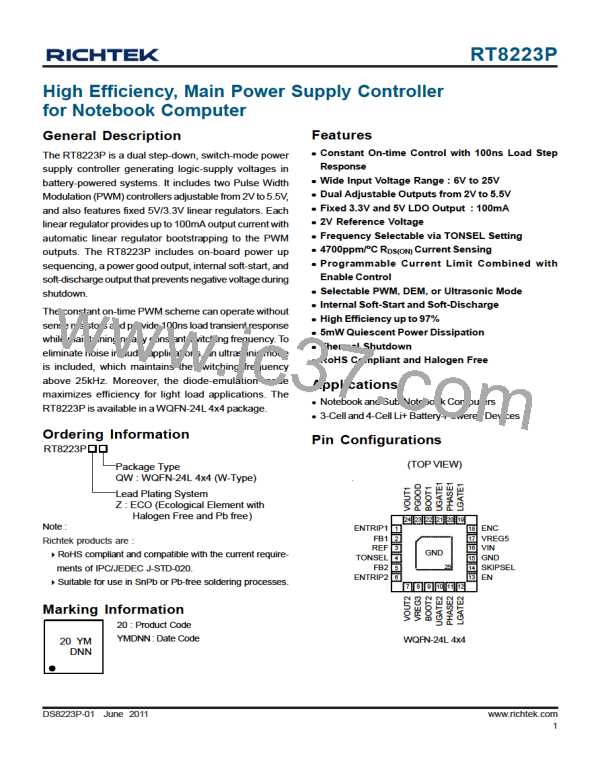RT8223P
Application Information
The RT8223P is a dual, Mach ResponseTM DRVTM dual
ramp valley mode synchronous buck controller. The
controller is designed for low voltage power supplies for
notebook computers. Richtek's Mach ResponseTM
technology is specifically designed for providing 100ns
“instant-on” response to load steps while maintaining a
relatively constant operating frequency and inductor
operating point over a wide range of input voltages. The
topology circumvents the poor load-transient timing
problems of fixed-frequency current mode PWMs while
avoiding the problems caused by widely varying switching
frequencies in conventional constant on-time and constant
off-time PWM schemes. The DRVTM mode PWM
modulator is specifically designed to have better noise
immunity for such a dual output application. The
RT8223P includes 5V (VREG5) and 3.3V (VREG3) linear
regulators. VREG5 linear regulator can step down the
battery voltage to supply both internal circuitry and gate
drivers. The synchronous-switch gate drivers are directly
powered from VREG5. When VOUT1 voltage is above
4.75V, an automatic circuit will switch the power of the
device from VREG5 linear regulator to VOUT1.
PWM Frequency and On-Time Control
The Mach ResponseTM control architecture runs with
pseudo constant frequency by feed-forwarding the input
and output voltage into the on-time one-shot timer. The
high side switch on-time is inversely proportional to the
input voltage as measured by VIN, and proportional to the
output voltage. There are two benefits of a constant
switching frequency. First, the frequency can be selected
to avoid noise-sensitive regions such as the 455kHz IF
band. Second, the inductor ripple current operating point
remains relatively constant, resulting in easy design
methodology and predictable output voltage ripple.
Frequency for the 3V SMPS is set at 1.25 times higher
than the frequency for 5V SMPS. This is done to prevent
audio-frequency “Beating” between the two sides, which
switch asynchronously for each side. The frequencies are
set by the TONSEL pin connection as shown in Table 1.
The on-time is given by :
tON = K×(VOUT / V )
IN
where “K” is set by the TONSEL pin connection (Table
1). The on-time guaranteed in the Electrical Characteristics
table is influenced by switching delays in the external
high side power MOSFET. Two external factors that
influence switching frequency accuracy are resistive drops
in the two conduction loops (including inductor and PC
board resistance) and the dead time effect. These effects
are the largest contributors to the change in frequency
with changing load current. The dead-time effect increases
the effective on-time by reducing the switching frequency.
It occurs only in PWM mode (SKIPSEL= REF) when the
inductor current reverses at light or negative load currents.
With reversed inductor current, the inductor's EMF causes
PHASEx to go high earlier than normal, thus extending
the on-time by a period equal to the low-to-high dead time.
For loads above the critical conduction point, the actual
switching frequency is :
PWM Operation
The Mach ResponseTM DRVTM mode controller relies on
the output filter capacitor's Effective Series Resistance
(ESR) to act as a current sense resistor, so the output
ripple voltage provides the PWM ramp signal. Refer to the
RT8223P's function block diagram, the synchronous high
side MOSFET will be turned on at the beginning of each
cycle. After the internal one-shot timer expires, the
MOSFET will be turned off. The pulse width of this one
shot is determined by the converter's input voltage and
the output voltage to keep the frequency fairly constant
over the input voltage range. Another one shot sets a
minimum off-time (300ns typ.). The on-time one shot will
be triggered if the error comparator is high, the low side
switch current is below the current limit threshold, and
the minimum off-time one shot has timed out.
f = (VOUT + VDROP1) / (tON ×(VIN + VDROP1 − VDROP2))
where VDROP1 is the sum of the parasitic voltage drops in
the inductor discharge path, which includes the
synchronous rectifier, inductor, and PC board resistances.
VDROP2 is the sum of the resistances in the charging path,
and tON is the on-time.
www.richtek.com
16
DS8223P-01 June 2011

 RICHTEK [ RICHTEK TECHNOLOGY CORPORATION ]
RICHTEK [ RICHTEK TECHNOLOGY CORPORATION ]